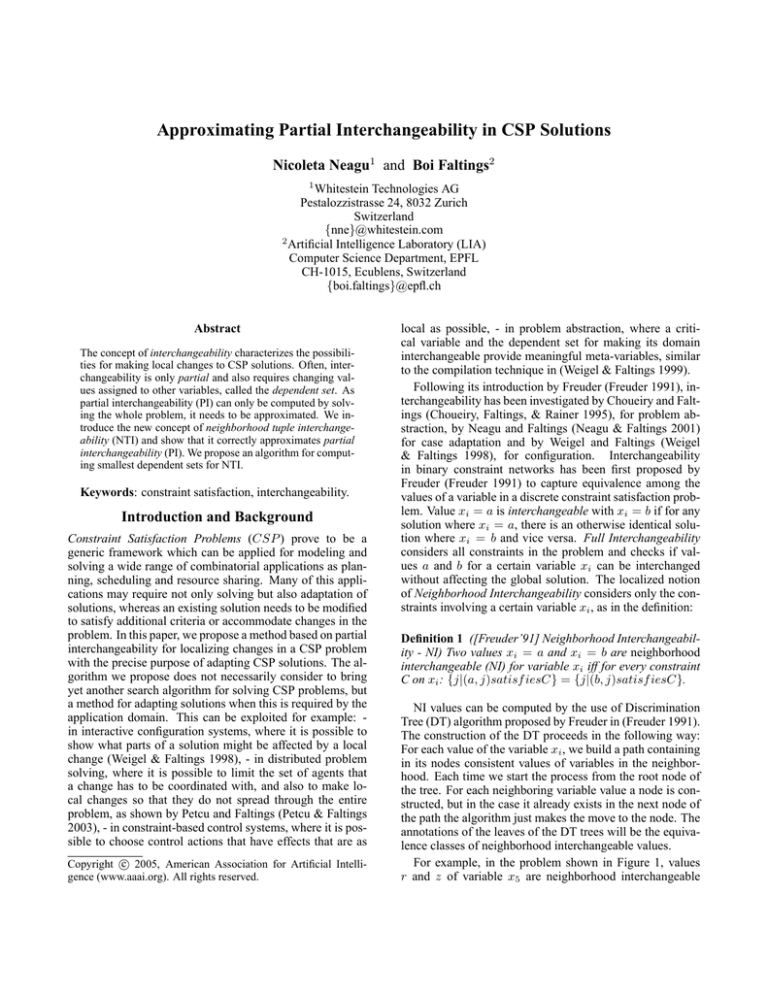
Approximating Partial Interchangeability in CSP Solutions
Nicoleta Neagu1 and Boi Faltings2
1
Whitestein Technologies AG
Pestalozzistrasse 24, 8032 Zurich
Switzerland
{nne}@whitestein.com
2
Artificial Intelligence Laboratory (LIA)
Computer Science Department, EPFL
CH-1015, Ecublens, Switzerland
{boi.faltings}@epfl.ch
Abstract
The concept of interchangeability characterizes the possibilities for making local changes to CSP solutions. Often, interchangeability is only partial and also requires changing values assigned to other variables, called the dependent set. As
partial interchangeability (PI) can only be computed by solving the whole problem, it needs to be approximated. We introduce the new concept of neighborhood tuple interchangeability (NTI) and show that it correctly approximates partial
interchangeability (PI). We propose an algorithm for computing smallest dependent sets for NTI.
Keywords: constraint satisfaction, interchangeability.
Introduction and Background
Constraint Satisfaction Problems (CSP ) prove to be a
generic framework which can be applied for modeling and
solving a wide range of combinatorial applications as planning, scheduling and resource sharing. Many of this applications may require not only solving but also adaptation of
solutions, whereas an existing solution needs to be modified
to satisfy additional criteria or accommodate changes in the
problem. In this paper, we propose a method based on partial
interchangeability for localizing changes in a CSP problem
with the precise purpose of adapting CSP solutions. The algorithm we propose does not necessarily consider to bring
yet another search algorithm for solving CSP problems, but
a method for adapting solutions when this is required by the
application domain. This can be exploited for example: in interactive configuration systems, where it is possible to
show what parts of a solution might be affected by a local
change (Weigel & Faltings 1998), - in distributed problem
solving, where it is possible to limit the set of agents that
a change has to be coordinated with, and also to make local changes so that they do not spread through the entire
problem, as shown by Petcu and Faltings (Petcu & Faltings
2003), - in constraint-based control systems, where it is possible to choose control actions that have effects that are as
c 2005, American Association for Artificial IntelliCopyright °
gence (www.aaai.org). All rights reserved.
local as possible, - in problem abstraction, where a critical variable and the dependent set for making its domain
interchangeable provide meaningful meta-variables, similar
to the compilation technique in (Weigel & Faltings 1999).
Following its introduction by Freuder (Freuder 1991), interchangeability has been investigated by Choueiry and Faltings (Choueiry, Faltings, & Rainer 1995), for problem abstraction, by Neagu and Faltings (Neagu & Faltings 2001)
for case adaptation and by Weigel and Faltings (Weigel
& Faltings 1998), for configuration. Interchangeability
in binary constraint networks has been first proposed by
Freuder (Freuder 1991) to capture equivalence among the
values of a variable in a discrete constraint satisfaction problem. Value xi = a is interchangeable with xi = b if for any
solution where xi = a, there is an otherwise identical solution where xi = b and vice versa. Full Interchangeability
considers all constraints in the problem and checks if values a and b for a certain variable xi can be interchanged
without affecting the global solution. The localized notion
of Neighborhood Interchangeability considers only the constraints involving a certain variable xi , as in the definition:
Definition 1 ([Freuder’91] Neighborhood Interchangeability - NI) Two values xi = a and xi = b are neighborhood
interchangeable (NI) for variable xi iff for every constraint
C on xi : {j|(a, j)satisf iesC} = {j|(b, j)satisf iesC}.
NI values can be computed by the use of Discrimination
Tree (DT) algorithm proposed by Freuder in (Freuder 1991).
The construction of the DT proceeds in the following way:
For each value of the variable xi , we build a path containing
in its nodes consistent values of variables in the neighborhood. Each time we start the process from the root node of
the tree. For each neighboring variable value a node is constructed, but in the case it already exists in the next node of
the path the algorithm just makes the move to the node. The
annotations of the leaves of the DT trees will be the equivalence classes of neighborhood interchangeable values.
For example, in the problem shown in Figure 1, values
r and z of variable x5 are neighborhood interchangeable
X5
X4
{ r, z, w, s}
{ y, w, s}
X2
X0
{ y , z, t }
{ y , v, t }
{ t}
X1
{ t, v, z, q}
X3
Figure 1: Example of a CSP problem.
(NI) 1 . Thus, interchanging r and z for variable x5 in any
solution does not require any changes in any other variable
in order to remain a solution. NI is important because any
values that are NI are also fully interchangeable, so NI can
be used as an incomplete approximation of FI. Interchangeability as defined above is quite rare in practice. Usually, exchanging values also requires making changes elsewhere in
the solution. Thus, in (Freuder 1991) Freuder also defined:
Definition 2 ([Freuder’91] Partial Interchangeability - PI)
Two values xi = a and xi = b are partially interchangeable
(PI) with respect to a set of variables S iff for any solution
involving one there also is an otherwise identical solution
involving the other, except possibly different values for variables in S. We call xi the critical variable, the set {a, b} the
interchangeable set and the set S the dependent set.
In the problem shown in Figure 1, values w and s for variable x5 are partially interchangeable with respect to the dependent set of variables S = {x4 }. Thus, when interchanging values w and s for x5 it may be necessary to change
also the value of x4 in order to maintain a consistent solution. There is no known algorithm for computing partial interchangeability without enumeration of all solutions.
Choueiry and Noubir (Choueiry & Noubir 1998) proposed a
localized algorithm for computing neighborhood partial interchangeability (NPI), using an algorithm based on a Joint
Discrimination Tree (JDT). A formal definition of NPI concept is as follows:
Definition 3 ([Choueiry&Noubir’98] Neighborhood Partial Interchangeability - NPI) A value b for a CSP variable xi is neighborhood partial interchangeable (NPI) with
a value c for xi given a dependent set S (which include
xi ) if and only if for every constraint C defined on the
variables (xi , xk ) where in xi ∈ S, xk ∈
/ S , we have:
{j|(b, j)satisf iesC} = {j|(c, j)satisf iesC}.
NPI values can be computed based on the JDT Algorithm,
see Algorithm 1. The JDT algorithm structures the possible
values of the critical variable and the dependent set by considering the assignments of their neighborhood that they are
consistent with. Each group of values that is compatible with
1
This CSP problem example was inspired and further extended
from one presented by Chouiery and Noubir in (Choueiry & Noubir
1998).
the same set of assignments to the neighborhood becomes a
leaf node and is indicated in the annotation of that node.
In the Figure 2, we show a graphical representation of the
JDT algorithm for the set of variables S = {x0 , x3 } of the
problem in the Figure 1.
1: Create the root of the Joint Discrimination Tree.
2: for variable xi ∈ S do
for value vil ∈ Dxi do
3:
4:
for variable variable xj ∈ Neigh(S) do
5:
for value value vjk ∈ Dxj consistent with vil do
6:
if there is a child node corresponding to ’xj =
7:
8:
9:
10:
11:
vjk ’ then
Then move to it,
else
Construct such a node and move to it.
Add ’xi , vil ’ to annotation of the node (or root).
Go back to the root of the discrimination tree.
Algorithm 1: Algorithm for computing the Joint Discrimination
Tree (JDT).
Not all partially interchangeable values can be detected
by neighborhood-based algorithms. For example, the critical variable x3 of the CSP in Figure 1 has a partially interchangeable set {t, z} with respect to the dependent set
S = {x2 } because the variable x0 will never take value t
in a consistent solution as necessarily x1 = t. Computing
this fact requires computing global consistency and is not
feasible with algorithms based on the neighborhood only.
Moreover, not all values detected by the NPI algorithm
are partially interchangeable. For the problem shown in Figure 1, by applying the NPI algorithm for critical variable
x3 and dependent set S = {x0 }, we obtain that values v
and q are NPI when x0 = {v}. However, values v and q
are not partially interchangeable for variable x3 relatively to
the dependent set S = {x0 } because for example, the solution x0 = v, x1 = t, x2 = y, x3 = q, x4 = s, x5 = w
has no identical solution where x3 = v with other changes
only in variable S = {x0 }. If x3 takes value v the value
of variable x2 would also have to change. So, according to
the Definition 2, values v and q for variable x3 are not PI
with respect to the set S = {x0 } but only with respect to
set S = {x0 , x2 }. So not all values detected by the NPI
algorithm are PI.
Neighborhood Tuple Interchangeability
In order to guarantee consistencies among variables in the
dependent set S, we introduce the concept of Neighborhood
Tuple Interchangeability (NTI) which is considering in the
computation of PI interchangeable values not only the outer
join semantics of the set S ∪ {xi } as NPI algorithm, but also
its inner join semantics. Thus, NTI is taking into account
also consistency of values assigned to variables in the dependent set S and values to interchange of the critical variable
xi .
Definition 4 (Neighborhood Tuple Interchangeability NTI) Values xi = a and xi = b are neighborhood tuple
interchangeable (NTI) with respect to a set of variables S if
Based on Theorem 3, this algorithm also provides a way to
test if a given interchangeable set can be PI at all. Finally,
we give experimental results about the occurrence of tuple
interchangeability and the size of dependent sets depending
on the CSP structure.
S = { X0, X3}
JDT (S)
root
X1= t
X2= y
X2= t
X4= y
X4= w
X4= s
X5 = r
X5 = z
X5 = w
X5 = s
X3 = z
X2= z
X2= z
X2= t
X2= t
X4= y
X4= y
X4= w
X4= w
X4= y
X4= w
X4= s
X4= s
X4= s
X5 = r
X5 = r
X5 = r
X5 = z
X5 = z
X5 = z
X5 = w
X5 = w
X5 = w
X5 = s
X5 = s
X5 = s
X3 = t
X3 = {q, v}
X0 = {v}
X0 = y
X2= y
Algorithm for Testing NTI
X2= z
X4= y
X4= w
X4= s
X5 = r
X5 = z
X5 = w
X5 = s
X0 = t
Figure 2: Joint Discrimination Tree (JDT) for set S = {x0 , x3 }.
for every consistent tuple t of value assignments to S ∪ {xi }
where xi = a there is another consistent tuple t0 where
xi = b such that t and t0 are consistent with the same value
combinations for variables outside of S. Additionally, the
same condition must hold with a and b exchanged.
For example, by applying the NTI algorithm we propose
in this paper for the critical variable x3 in Figure 1 and the
interchangeable sets I1 = {t, z} or I2 = {q, v}, our NTI
algorithm finds as dependent set the set of variables S =
{x0 , x2 } and its corresponding interchangeable tuples, see
Table 1.
For NTI, we can show the following properties:
Theorem 1 (Extensivity: NTI =⇒ NPI) Consider a critical
variable xi . If values a and b are NTI with dependent set S,
then they are NPI with dependent set S.
Due to lack of space, the proofs of the theorems are
not presented in the paper but they can be found on line
at (Neagu & Faltings 2005).
Theorem 2 (Extensivity: NTI =⇒ PI) Consider a critical
variable xi . If values a and b are NTI with dependent set S,
then they are PI with dependent set S.
Theorem 3 Let I be a partially interchangeable set for critical variable xi with dependent set S. Then I is also a neighborhood tuple interchangeable set for xi with dependent set
S 0 ⊇ S.
In most cases, it will not be necessary to extend the dependent set to the entire problem to obtain N T I. For example, in the problem shown in Figure 1, the set I = {t, z}
is partially interchangeable for the variable x3 with the dependent set S = {x2 }. This happens because variable x0
would never take value t. Using NTI, we can find that I is a
neighborhood tuple interchangeable set for variable x3 with
dependent set S 0 = {x0 , x2 }, where S 0 ⊇ S.
In this paper we propose an algorithm for computing tuple interchangeability. We first describe an algorithm that
test for NTI using a novel structure called the joint tuple
tree (JTT). We then present an algorithm that incrementally
searches for a minimal dependent set containing NTI tuples.
Firstly, we present an algorithm for testing whether a given
interchangeable set is indeed neighborhood tuple interchangeable. This algorithm is based on the JDT algorithm
described in previous section.
When searching for tuple interchangeability, it is sufficient to consider only a part of the JDT, namely the branch
corresponding to the values of the interchangeable set. We
thus define:
Definition 5 (Reduced JDT) A reduced JDT is a JDT where
we consider only the neighborhood assignments that are
consistent with all values in the interchangeable set. We call
these assignments the Common Assignments.
In Figure 3, in the left side, one can see the reduced JDT
for the set S = {S1 ∪ {x3 }}, where S1 = {x0 }, relatively
to critical variable x3 .
Thus, all branches of the reduced JDT involve only subsets of the common assignments. Each branch leads to a JDT
node that carries an annotation. We structure these nodes
into a Joint Tuple Tree (JTT) that reflects the subset relations
between the corresponding branches of the reduced JDT:
Definition 6 (Joint Tuple Tree (JTT)) A Joint Tuple Tree is
a tree which contains as nodes the leaves of the reduced JDT
for a critical variable xi and a dependent set S. A node n is a
child of a node n0 if the set of compatible assignments of n is
a subset of that of n0 and if there is no other n00 such that n00
would be child of n and n0 child of n00 . We annotate the arc
between n and n0 by the variables involved in assignments
that are consistent with n0 but not with n.
For example, we consider that variable x3 in Figure 1,
an interchangeable set I = {q, v} and a dependent set
S1 = {x0 }. Whereas the reduced JDT is shown in Figure 3 on the left side, the right side of Figure 3 shows the
JTT obtained from the annotations of the reduced JDT. The
root node contains in its annotation the critical variable x3
and the interchangeable set I = {q, v}. All the other nodes
have assignments that are subsets of the root node assignment, and thus they become children of the root node. For
example, as the annotation x0 = y has the assignments a
subset of the annotation x3 = {q, v}, it becomes its child.
Algorithm 2 constructs the JTT from the reduced JDT.
Note that as NTI implies NPI, there must be a leaf node of
the reduced JDT that contains the interchangeable set in its
annotations; otherwise, the values cannot be NTI. This leaf
becomes the root node of the JTT. The other leaves become
nodes of the JTT. Arcs between the nodes are constructed as
in Definition 6 between nodes whose annotations are subsets
of one another.
We now consider the use of the JTT for computing tuple
interchangeability. We associate the different consistent tuples of the dependent set with nodes of the JTT using the
notion of admissibility:
X3 - critical variable
S1 = { X0}
Reduced JDT ({S1 U X3})
X3 - critical variable
JTT (S1)
root
X3 = {q, v}
X1 = t
(X3=q, X0=v)
X0 = {v}
X2= y
X2= z
X2= z
X2= t
X2= t
X4= y
X4= y
X4= w
X4= w
X4= s
X4= s
X5 = r
X5 = r
X5 = z
X5 = z
X5 = w
X5 = w
X5 = s
X5 = s
X2
X2= y
X2, X4
X2= z
X4= y
X0 = t
X4= w
X0 = y
X4= s
X5 = r
(X3=q, X0=v)
(X3=q, X0=y)
(X3=v, X0=y)
(X3=q, X0=v)
(X3=q, X0=t)
(X3=v, X0=t)
X5 = z
X5 = w
X5 = s
- admissible tuples
X3 = {q, v}
X0 = y
X0 = t
X0 = {v}
Figure 3: Reduced Joint Discrimination Tree (JDT) for the critical variable x3 , interchangeable set I = {q, v} and dependent
set S1 = {x0 } (left side). Joint Tuple Tree (JTT) for the critical variable x3 , interchangeable set I = {q, v} and dependent set
S1 = {x0 } (right side).
Definition 7 (Admissible Tuples) The admissible tuples at a
node n of the Joint Tuple Tree(JTT) are all the combinations
of the variable/value assignments to the critical variable and
dependent set that are consistent with all assignments on the
corresponding branch of the JDT.
Lemma 1 A consistent tuple t that contains a value of the
interchangeable set and is consistent with the neighborhood
will be admissible at some node of the JTT.
Theorem 4 Admissible tuples of a JTT node are interchangeable.
The JTT decomposes the different possible value assignments to variables in the neighborhood of the dependent set
into environments represented as nodes. Each environment
represents a combination of value assignments such that the
1: T ← root node, r = leaf node with interchangeable set
in reduced JDT.
2: l ← remaining leaf nodes of the reduced JDT.
3: repeat
4:
n ← node in l such that no other node n0 is compati-
ble with all assignments on the path to n.
p ← deepest node in T that is compatible with all the
assignments on the path to n.
6:
make n a child node of p; remove n from l.
7:
annotate the arc between p and n with the variable involved in assignments consistent with the annotation
of p but not consistent with the annotation of n.
8: until l is empty
5:
Algorithm 2: Algorithm for computing the Joint Tuple Tree (JTT).
admissible tuples are the same. In order to have neighborhood tuple interchangeability, the admissible tuples for
each environment must either contain a tuple for each interchangeable value, or no tuple with any of the interchange-
able values. This is expressed by the notion of compatibility,
defined as follows:
Definition 8 (Compatibility) We call the subtree of the joint
tuple tree rooted at node n compatible if either: (1) - for
each value in the interchangeable set, the JTT admissible
tuples at node n contain at least one tuple where the critical
variable takes that value or (2) - the admissible tuples at
node n contain no tuple where the critical variable takes a
value in the interchangeable set, and all subtrees rooted at
children of node n are compatible.
For example, in Figure 3 all the tree nodes of the JTT are
compatible. The two children are compatible because their
admissible tuples contain at least one tuple for the values to
interchange x3 = q and x3 = v, and the root node is also
compatible since it has as children compatible nodes, even
thou it does not have an admissible tuple for value x3 = v.
To show that the values in the interchangeable set are indeed partially interchangeable, we need to show that every
tuple containing one is an interchangeable tuple containing
the other. Due to the structure of the JTT, we can test this
using the following:
Lemma 2 The values in the interchangeable set are NTI
with respect to set S if and only if the JTT is compatible
from the root node.
In certain cases, the JTT also allows us to determine that
values are not interchangeable for S or any superset:
Lemma 3 If the root of the JTT is not compatible, and there
is a value in the interchangeable set that does not occur in
any of the admissible tuples of the nodes of the JTT, the values are not NTI for set S or any superset of set S.
Complexity of JTT Algorithm: Consider the computation of the JTT for a dependent set S of size s and a maximum domain size d. There are at most s · d variable-value
combinations. Each occurs in at most one leaf of the JDT
so the number of leaves in the JDT and the number of nodes
in the JTT is bounded to s · d. In the worst case, the algorithm has to check for each leaf of the JDT whether the
neighborhood values are consistent with a subset of the values contained in all the other leaf nodes; there are O((s·d)2 )
such tests. Each test requires at most (n − s) · d2 operations.
The total complexity is O(s2 · (n − s) · d4 ), thus polynomial
in both s and d.
Algorithm for computing NTI
The NTI algorithm goal is to determine a minimal set to
which the change in one CSP variable can be localized. For
this purpose, we now consider an algorithm for determining
a minimal dependent set S that would make a set I neighborhood tuple interchangeable.
Algorithm 3 for computing NTI values is based on the
JTT (Algorithm 2), the discrimination algorithms proposed
by Freuder in (Freuder 1991) and by Choueiry and Noubir
in (Choueiry & Noubir 1998). It takes as input a critical
variable xi and an interchangeable set I. It determines a
dependent set S of minimum size such that I is NTI with
this dependent set. If no such set exists, it returns failure.
The algorithm first computes the discrimination tree (DT)
for the critical variable xi to check whether if its interchangeable set I is neighborhood interchangeable. If this
is the case, it returns with S = φ. If not, it uses the DT to
determine which variables to include in the initial candidate
dependent set S.
X3 - critical variable
S2 = { X0, X2}
Reduced JDT ({S2 U X3})
X3 - critical variable
JTT (S2)
(x3 : q x2 : z x0 : y)
root
(x3 : q x2 : z x0 : v)
X1 = t
(x3 : q x2 : t x0 : y)
X4= y
X4= y
X4 = s
(x3 : q x2 : t x0 : v)
X4 = s
X0 = {y, v}
X2 = {z, t}
X3 = {q, v}
X4 = s
X4= w
1: construct DT for xi .
2: if interchangeable set values are NI then
3:
return (success, S = φ).
4: else
5:
S ← variables that are involved in DT assignments
6:
7:
8:
9:
10:
11:
12:
13:
14:
15:
16:
17:
18:
19:
20:
that are consistent with some values in the interchangeable set but not all.
OP EN ← ({S})
repeat
S ← f irst(OP EN ), OP EN ← rest(OP EN ).
construct JDT for S.
construct JTT.
if root node compatible then
return (success, S).
else
c ← sets of minimal combinations of nodes of
the JTT such that the union of their admissible
tuples contains each value of the interchangeable
set at least once.
for c ∈ C do S
N S ← S ∪ n∈C . annotations of the arcs
which are on the path from root of JTT to node
n.
if N S ∈
/ OP EN then
include N S in OPEN s. th. OPEN is ordered in increasing size.
until OP EN = φ
return failure.
X4= w
X5= z
X5= z
X5 = w
X5 = w
X5 = r
X5 = r
X5 = s
X4= w
(x3 : v x2 : z x0 : y)
(x3 : v x2 : t x0 : y)
X5= z
X5 = w
X5 = r
X4
X5 = s
X1
X5 = s
X0 = { y, v}
X2 = {z, t}
X3 = {q, v}
X2 = y
X0 = t
X3 = y
X2 = y
X0 = t
- admissible tuples
Figure 4: Joint Discrimination Tree (JDT) for the critical variable x3 , interchangeable set I = {q, v} and dependent set
S = {x0 , x2 } (left side). Joint Tuple Tree (JTT) for the critical
variable x3 , interchangeable set I = {q, v} and dependent set
S = {x0 , x2 } (right side).
S variable x2 which makes the difference between the root
node of the JTT and node x0 = y, see Figure 3.
x5 , S = {x4 }
Ix5 = {w, s}
(x5 , x4 )
x3 , S = {x2 , x0 }
Ix3 = {t, z}
(x3 , x2 , x0 )
x3 , S = {x2 , x0 }
Ix3 = {q, v}
(x3 , x2 , x0 )
(w, s)
(s, w)
(t, z, y)
(t, z, v)
(z, t, y)
(z, t, v)
(q, z, y)
(q, z, v)
(q, t, y)
(q, t, v)
(v, z, y)
(v, t, y)
Table 1: Interchangeable tuples for different critical variables
Algorithm 3: Algorithm for computing NTI. Input : critical variable xi and interchangeable set I.
All assignments which place values in I in different
branches in the DT must be included in any dependent set S
for the NTI. It then enters a search for a minimal dependent
set S, considering them in the order of increasing size to ensure that the smallest is found first. For each candidate set, it
computes first the JDT and then the JTT using Algorithm 2.
It then checks whether the JTT is compatible according to
Definition 8. If it is, then S is a correct dependent set and
the algorithm terminates.
If the JTT is not compatible, the algorithm generates all
possible candidates for S that could provide a set of admissible tuples containing all values in the interchangeable set,
and thus a compatible JTT. It adds these to the list of candidates, and continues with the next candidate.
Following the example given in the previous subsection
for the computation of tuple interchangeability for variable
x3 and its interchangeable set I = {q, v}, we can see in
Figure 3 that the root node of the JTT obtained in the right
side of the figure is not compatible. Thus, the computation
continues according to Algorithm 3 by including in the set
and interchangeable sets for the CSP of Figure 1.
Note that we choose node x0 = y of the JTT since the
other node would require to extend the set S more, with x2
and x4 as well. Further, the computation continues with the
construction of the JDT for the new set S and its corresponding JTT as in Figure 4. The computation stops here since the
root node of the JTT is compatible and returns the obtained
set S and the corresponding interchangeable tuples.
We display more results by applying the NTI algorithm
for the variables of the problem shown in Figure 1 in the
Table 1. We can see that for the critical variable x5 and interchangeable set I = {w, s}, we obtained the dependent set
S = {x4 }. For variable x3 by interchanging values {t, z} or
{v, q} the dependent set obtained is S = {x2 , x0 } on different domain partitions and thus different values in tuples.
Theorem 5 Algorithm 3 is sound: if it returns a dependent
set S, then the set I is Neighborhood Tuple Interchangeable
for the critical variable xi . Algorithm 3 is also complete: if
the set I is NTI for xi , then it will find a smallest dependent
set S for this interchangeability.
Complexity of NTI Algorithm: The NTI algorithm com-
plexity is generated by the computation of the JDT and JTT
data structures it uses. The complexity of the JTT algorithm
as presented earlier in this paper is O(s2 · (n − s) · d4 ) where
n is the number of CSP variables, s is the size of the dependent set for which the JTT is constructed and d the largest
domain size. In the worst case, the NTI algorithm constructs
the JTT for all possible dependent sets in the neighborhood
of the critical variable up to size smax where an interchangeability is found or not. Thus, it can call the JTT algorithm at
most O(nsmax ) times, and the worst case computation time
is O((nsmax )smax (n − smax )d4 ). Fortunately, we will see
in the analysis on random problems that smax is on average
quite small.
Experimental results
We report our results obtained during empirical study for
NTI occurrence over random generated problems. During
our experimental study we notice that NTI values occurrence
depends mostly on the CSP tightness. In our experiments,
we measured two parameters of the NTI occurrence: the average tuple size per variable, Avs and the average number of
interchangeable tuples per variable, Avt . Both measures are
obtained by computing the sets of interchangeable tuples for
each value pair of each variable normalized to the domain
size of the variable. Due to lack of space, we present here
only the results for Avs measure; the others can be found
in an extended version of this paper at (Neagu & Faltings
2005).
CSP tightness; the interchangeable tuples size does not depend on the problem size, while the number of interchangeable tuples increases with the problem size. Both measures
increases with the domain size.
Conclusions
Interchangeability is an interesting but not very deeply explored concept in constraint satisfaction. In this paper, we
have developed the first algorithm that allows to find partial
interchangeabilities without solving the entire problem. It is
based on the concept of Neighborhood Tuple Interchangeability, which turns out to be more useful than Neighborhood
Partial Interchangeability as defined earlier by Choueiry and
Noubir (Choueiry & Noubir 1998).
We have given an algorithm that computes a smallest dependent set S for a desired interchangeability. If the algorithm finds such a set, it is guaranteed that the set is indeed
partially interchangeable, but possibly with a smaller dependent set. An interesting result is provided by Theorem 3:
if the set is found to be not NTI, then it can also be guaranteed to not be partially interchangeable at all. Thus, we
actually have a complete method to compute all partial interchangeabilities; however, it does not necessarily find the
smallest dependent sets. In experiments on random problems, we found that in general most values seem to become
interchangeable with dependent sets of manageably small
size. Thus, while the complexity of our methods are exponential in the size of the dependent sets, we do not expect
this to be a great problem in practice.
5
References
4.5
measure Average Dependent Set
4
3.5
3
2.5
2
1.5
1
0.5
0
0.1
0.2
0.3
0.4
0.5
tightness
0.6
0.7
0.8
0.9
Figure 5: The dependence of the interchangeable tuple size (Avs )
on the CSP tightness.
In Figure 5, we study how the interchangeable tuples measure Avs , defined above, varies with the CSP tightness. For
each data point, we generated 20 random problems with
the following parameters : number variables = 10, domain size = 10, CSP density varies randomly in the interval
[0.1, 0.9] and CSP tightness varies for each point in the set
{0.1, 0.3, ..., 0.9}. We can observe that the average tuple
size, Avs , increases with the CSP tightness. Note that we
count in our measurements also tuples of one variable, thus
the NI values. From our empirical experimentation we retrieve the following conclusions: the interchangeable tuple
size and number do not depend on the CSP density; the interchangeable tuple size and number increases with the CSP
tightness, where the number of tuples is more sensitive to the
Choueiry, B., and Noubir, G. 1998. On the Computation
of Local Interchangeability in Discrete Constraint Satisfaction Problems. In Proc. of AAAI-98, 326–333.
Choueiry, B.; Faltings, B.; and Rainer, W. 1995. Abstraction by interchangeability in resource allocation. In Proc.
of the IJCAI-95, 1694–1701.
Freuder, E. C. 1991. Eliminating Interchangeable Values
in Constraint Satisfaction Problems. In Proc. of AAAI-91,
227–233.
Neagu, N., and Faltings, B. 2001. Exploiting Interchangeabilities for Case Adaptation. In Proc. of ICCBR-01, 422–
437.
Neagu, N., and Faltings, B. 2005. Approximating
Partial Interchangeability in CSP Solutions. In http :
//liawww.epf l.ch/P ublications/, In Proc. of FLAIRS05.
Petcu, A., and Faltings, B. 2003. Applying Interchangeability Techniques to the Distributed Breakout Algorithm.
In Proc. of IJCAI-03.
Weigel, R., and Faltings, B. 1998. Interchangeability for
Case Adaptation in Configuration Problems. In Proc. of the
AAAI-98.
Weigel, R., and Faltings, B. 1999. Compiling Constraint
Satisfaction Problems. Artificial Intelligence 115, pg. 257287.







